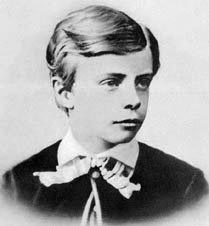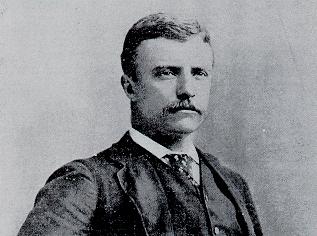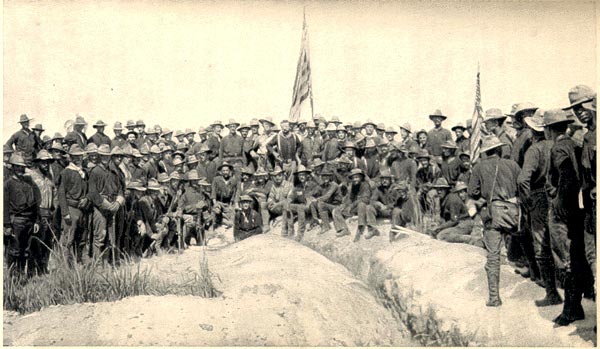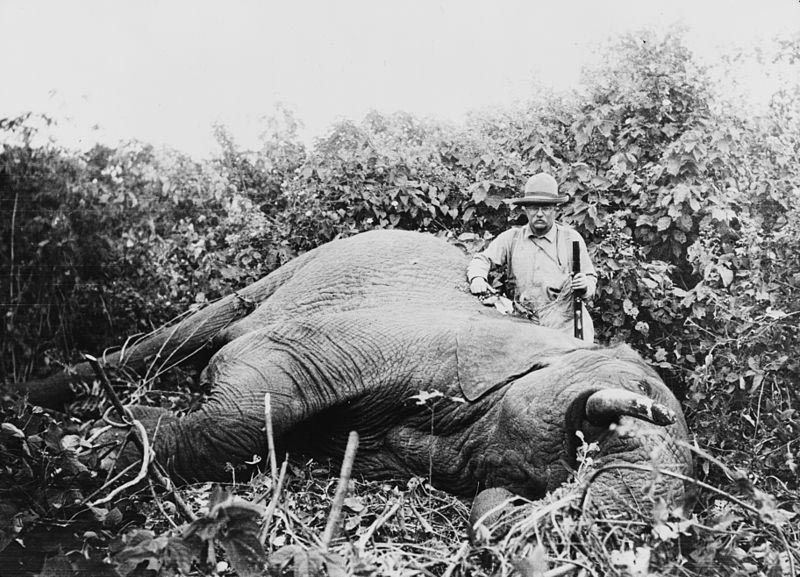| Theodore Roosevelt | |
|---|---|
 |
|
| 26th United States President « Previous Next » |
|
| In office | Sep. 14, 1901 – Mar. 4, 1909 |
| V. President | Charles Fairbanks |
| Political Party | Republican |
| Personal Info | |
| Born | Oct. 27, 1858 |
| Died | Jan. 6, 1919 (at age 60) |
| Religion | Presbyterianism |
| School | Harvard University |
| Columbia University | |
| Profession | Author, Historian, Explorer, Conservationist, Civil servant |
| Signature | |
| Wife | Alice Hathaway Lee (1880–1884) |
| Edith Carrow (1886–1919) | |
| Children | Alice Roosevelt Longworth Theodore Roosevelt Jr. Kermit Roosevelt Ethel Roosevelt Derby Archibald Roosevelt Quentin Roosevelt |
| U.S. Presidents 26-35 | |
| 26. Theodore Roosevelt (1901-1909) | |
| 27. William H. Taft (1909-1913) | |
| 28. Woodrow Wilson (1913-1921) | |
| 29. Warren G. Harding (1921-1923) | |
| 30. Calvin Coolidge (1923-1929) | |
| 31. Herbert Hoover (1929-1933) | |
| 32. Franklin D. Roosevelt (1933-1945) | |
| 33. Harry S. Truman (1945-1953) | |
| 34. Dwight D. Eisenhower (1953-1961) | |
| 35. John F. Kennedy (1961-1963) | |
| List of All the Presidents |
“Speak softly and carry a big stick, and you will go far.”
Theodore “Teddy” Roosevelt was the 26th President of the United States at the age of 42. He followed President William McKinley and later succeeded by President William Howard Taft. Prior to being President, he was a New York State Assemblyman, 33rd Governor of New York, and Vice President of the United States for six months under President McKinley.
He was Assistant Secretary of the Navy, and Colonel of the Rough Riders for which he was posthumously awarded the Medal of Honor in 2001. He was a popular politician especially for his contributions in: resource conservation; building of the Panama Canal; curbing the powers of large corporations; and negotiating an end to the Russo-Japanese war which won for him a Nobel Peace Prize in 1906.
Early Life
TTheodore Roosevelt, nicknamed “Teddy”, was born on October 27, 1858 in New York City into a family of prominence. His parents, Theodore Roosevelt, Sr. and Martha “Mittie” Bullock were of Dutch origins. He had three siblings, Anna, Corrine, and Elliott, (the father of Eleanor Roosevelt, future First Lady of the United States). Teddy was asthmatic and tone-deaf as a child which led him to be home-schooled.
 Despite his physical limitations, he remained active and was passionate about nature, animals, and all things related to natural history. At the age of nine, he took boxing lessons, in addition to compiling a collection entitled “The Natural History of Insects.” Roosevelt was married in 1880 to Alice Hathaway Lee of Massachusetts. She died of kidney failure at a young age, two days after giving birth to their daughter, Alice. On the same of day of Alice’s death, Roosevelt’s mother also died of typhoid fever.
Despite his physical limitations, he remained active and was passionate about nature, animals, and all things related to natural history. At the age of nine, he took boxing lessons, in addition to compiling a collection entitled “The Natural History of Insects.” Roosevelt was married in 1880 to Alice Hathaway Lee of Massachusetts. She died of kidney failure at a young age, two days after giving birth to their daughter, Alice. On the same of day of Alice’s death, Roosevelt’s mother also died of typhoid fever.
He later married Edith Kermit Carow 1886, a childhood sweetheart. They had five children, Theodore Jr., Kermit, Ethel, Archibald, and Quentin. Roosevelt would never speak of his wives again, publicly or privately, nor mention them in his autobiographies.
Education and Early Public Service
In 1876, Roosevelt attended Harvard Colelge where he excelled in Science, Philosophy, and Speech. At this age, he had published works in Ornithology, a study of birds. Roosevelt had a photographic memory and loved to read.
While at Harvard, he studied about the participation of the US Navy in the War of 1812 that led to his writing a book. It was carefully researched and included drawings, charts, and analysis on a ship-to-ship level. The book was published after Roosevelt’s graduation from college and was entitled “The Naval War of 1812.” The book is renowned for its academic content and style. It became a required reading at the Naval Academy for many years. The book established Roosevelt as a critical historian.
He graduated from Harvard in 1880, Magna Cum Laude and member of Phi Beta Kappa. He was also a runner-up in the Harvard boxing championship. He later went to Columbia Law School. In 1881, he was offered to run as a New York Assemblyman. Roosevelt opted to drop-out of law school to pursue his political career. As an assemblyman, he wrote state bills that outdid other New York legislators.
Life in North Dakota
After his stint as an assemblyman, Roosevelt was disillusioned and frustrated. He went away to North Dakota where he built a ranch and named it Elk Horn. Here he lived the life of a cowboy, raising cattle, hunting and policing. He became Deputy Sheriff and befriended Seth Bullock, the famous sheriff of Deadwood, South Dakota. Unfortunately, the winter of 1886 decimated his cattle. He returned back East and built his estate in Sagamore Hill at Oyster Bay where he would later die in his sleep in 1919.
Returning to New York
 Upon returning to New York, Theodore Roosevelt slowly re-entered the public life. He campaigned for (President) Benjamin Harrison who appointed Roosevelt to the United States Civil Service Commission where he worked until 1895. During his service, he mandated the implementation of civil service laws. He was unstoppable and during this time, he was described as irrepressible, belligerent, and enthusiastic. Succeeding Harrison as president was Grover Cleveland who also appointed Roosevelt to the same post.
Upon returning to New York, Theodore Roosevelt slowly re-entered the public life. He campaigned for (President) Benjamin Harrison who appointed Roosevelt to the United States Civil Service Commission where he worked until 1895. During his service, he mandated the implementation of civil service laws. He was unstoppable and during this time, he was described as irrepressible, belligerent, and enthusiastic. Succeeding Harrison as president was Grover Cleveland who also appointed Roosevelt to the same post.
In 1895, Roosevelt became the President of the board of New York City Police Commissioners. At that time, the NYPD was one of the most corrupt police force in America. Under Roosevelt’s term, significant reforms were made. These included new disciplinary rules, standardization of the use of pistols, monitoring traffic problems, regular inspection of firearms, and physical examination of new recruits.
He initiated the bicycle squad for New York policemen and the giving out of meritorious service medals to deserving officers. He also established the foundation for present-day police academies when he ordered that all policemen should attend target practice. His final act as president of the board of NYCPC was to appoint a single Police Commissioner instead of having several people assuming this post.
Life as Assistant Secretary of the Navy and the Establishment of the Rough Riders
 Theodore Roosevelt’s prominence in the political arena came when he was appointed as Assistant Secretary of the Navy under President William McKinley in 1897. He prepared the Navy for the Spanish-American war in 1898 by building up the weapons and supplies inventory. Upon the declaration of the war, Roosevelt formed the First US Volunteer Cavalry Regiment, better known as the “Rough Riders”.
Theodore Roosevelt’s prominence in the political arena came when he was appointed as Assistant Secretary of the Navy under President William McKinley in 1897. He prepared the Navy for the Spanish-American war in 1898 by building up the weapons and supplies inventory. Upon the declaration of the war, Roosevelt formed the First US Volunteer Cavalry Regiment, better known as the “Rough Riders”.
The Rough Riders gallantly took charges up Kettle Hill and San Juan Hill. In 2001, Roosevelt was posthumously awarded the Medal of Honor for his role in the establishment of the Rough Riders. Soon after the war, Roosevelt had been recommended to receive the Medal of Honor which was later denied. Roosevelt believed the disapproval was brought about by his action to send home wounded and sick soldiers. His sharp letters about the matter were disclosed to the press, infuriating the Secretary of War, Russell Alger and President McKinley.
Vice Presidency and Presidency
His political career progressed when he became the 33rd Governor of New York in 1898, he was a member of the Republican party. Roosevelt made such an impression in taking out corruption that he was asked to be the running mate of William McKinley for the 1900 presidential elections. His Vice Presidency was short-lived and uneventful due to the assassination of President McKinley in 1901 during the Pan American Exposition in New York.
On September 14, 1901, after six months holding office as Vice President, Theodore Roosevelt was sworn in as the 26th President of the United States. In the 1904 presidential elections, Roosevelt became president again in a landslide victory, with Charles Fairbanks as his vice president.
During his term as President, Roosevelt was most known for his conservation acts where he designated 150 National Forests, 51 Federal Bird Reservations, 5 National Parks, 18 National Monuments, four National Game Reserves, and 21 Reclamation Projects, most of which were the first endeavors undertaken by the government. He also provided federal protection for approximately 230 million acres of land.
He was also notoriously known as the “trust buster” where he restrained the power and control of large corporations of America and handed it over to the people. In so doing, business regulations increased. He wanted the Americans to have a “square deal” enabling them to earn a living and having a fair share of America’s income. All this was part of Roosevelt’s agenda in moving the Republican Party toward Progressivism.
As a strategist, Roosevelt saw the opportunity of a shortcut between the Atlantic and the Pacific. Thus, he pursued the construction of the Panama Canal. In other areas, Theodore Roosevelt intervened in the Russo-Japanese War and negotiated for its end. For his efforts, he was awarded the Nobel Peace Prize in 1906, becoming the first American to be awarded this prize. In his effort to establish the United States as a world power, he commissioned the Great White Fleet on a world tour for goodwill. This endeavor demonstrated the American naval power to the world. This was the first circumnavigation tour around the world made by a national naval force.
Always concerned about the welfare of the American people, Roosevelt enabled the passing of The Meat Inspection Act of 1906 which prohibited the use of misleading labels and harmful preservatives. He also supported The Pure Food and Drug Act which restricted production, selling, and shipping of adulterated food and drugs.
Other accomplishments under Roosevelt’s name include the settlement of the Venezuelan affair, establishment of the Department of Commerce and Labor, Elkins Anti-rebate Act for railroads, settlement of the Alaskan Boundary dispute, mediation of dispute between France and Germany over Morocco, the Hepburn Act of 1906 which gave the interstate Commerce Commission the power to regulate railroad rates. Roosevelt also managed to make the White House the center of daily news coverage, thus, the start of the presidential press briefing sessions.
 At the end of his second term in 1908, Theodore Roosevelt declined to run for presidency and instead supported William Taft. In March 1909, he went on a safari trip to Africa with a team of scientists and game hunters. Included in the team were R. J. Cunningham, a legendary hunter.
At the end of his second term in 1908, Theodore Roosevelt declined to run for presidency and instead supported William Taft. In March 1909, he went on a safari trip to Africa with a team of scientists and game hunters. Included in the team were R. J. Cunningham, a legendary hunter.
The team’s intent was to collect samples for the Smithsonian Institute and American Museum of Natural History. This endeavor resulted to the collection of 11,397 animals, ranging from insects to big animals like elephants and hippopotamuses. Later, Roosevelt would capture the details of the hunting trip in his book entitled “African Game Trails”.
The William Taft Administration and Roosevelt’s Second Presidential Campaign
The United States was left in the hands of President William Taft whom Roosevelt had supported. Nonetheless, Taft proved to be a less skillful politician than Roosevelt. His policies, especially on tariffs, were not in agreement with those of Roosevelt. Internal friction was building-up inside the Republican Party which eventually resulted in a loyalty split.
Late in 1911, Roosevelt announced his candidacy for republican nomination for the upcoming 1912 presidential elections. Roosevelt created the Progressive Party or known as the “Bull Moose Party”. The battle cry of the party was, “To dissolve the unholy alliance between corrupt business and corrupt politics.”
An assassination attempt was made on the life of Theodore Roosevelt on October 14, 1912. Roosevelt went on to deliver a 90-minute campaign speech in Milwaukee while bleeding from his chest and before seeking medical attention. He survived the gunshot although he carried the bullet with him for the rest of his life. This caused the deterioration of Roosevelt’s health and also cost him electoral votes. Woodrow Wilson, a Democrat, won.
 Theodore Roosevelt’s passion for exploration did not waiver despite his condition. He embarked on an expedition to South America on December 9, 1913 again to put together a collection of new specimens. The team was led by Candido Rondon, a Brazilian explorer. This trip was described in Roosevelt’s book entitled, “Through the Brazilian Wilderness.” The safari’s objectives also included finding the headwaters of Rio da Duvida or the River of Doubt.
Theodore Roosevelt’s passion for exploration did not waiver despite his condition. He embarked on an expedition to South America on December 9, 1913 again to put together a collection of new specimens. The team was led by Candido Rondon, a Brazilian explorer. This trip was described in Roosevelt’s book entitled, “Through the Brazilian Wilderness.” The safari’s objectives also included finding the headwaters of Rio da Duvida or the River of Doubt.
Roosevelt suffered a leg injury which led to tropical fever, similar to malaria. Despite this, he continued on with the journey, trekking more than 625 miles of uncharted river. While there was much question about his exploration of the Rio da Duvida, Roosevelt ably defended his claims and the river was later renamed Rio Roosevelt after Theodore Roosevelt and his expedition team.
World War I
 During World War I, Roosevelt supported the Allies. He held very strong views against Irish-Americans and German-Americans, questioning their loyalties. He was also very vocal about his disagreement with the foreign policies of then President Wilson. When the United States entered the World War I in 1917, Roosevelt wanted to augment the infantry division by enlisting volunteers.
During World War I, Roosevelt supported the Allies. He held very strong views against Irish-Americans and German-Americans, questioning their loyalties. He was also very vocal about his disagreement with the foreign policies of then President Wilson. When the United States entered the World War I in 1917, Roosevelt wanted to augment the infantry division by enlisting volunteers.
President Wilson did not agree and would not allow it. Roosevelt’s strikes against the Wilson administration helped the Republicans gain control again of Congress. Theodore Roosevelt was back in the political limelight and could have very well contested the 1920 Republican nomination. However, because of his condition after the journey to Brazil, his health did not allow him to participate as much as he wanted. Hence, he threw his support to General Leonard Wood who was subsequently defeated by Warren G. Harding.
He wanted to remain active in the political arena, but Theodore Roosevelt’s health had deteriorated significantly, and he died on January 6, 1919 of a heart attack at his home in Sagamore Hill, Oyster Bay, New York at the age of 60.